modern jazz voicings pdf free download
JAZZ GUITAR LESSONS
Learn how to play jazz guitar with our free jazz guitar lessons covering scales, chords, modes, improvisation, guitar technique, theory, and much more.
Whether you're an absolute beginner or an advanced guitarist, our guitar lessons and exercises will help take your musicianship to the next level!
Get started playing jazz guitar!
Download your free eBook by
filling out the form below:
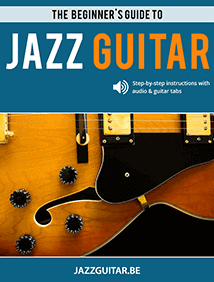
Jazz Guitar Lessons For Beginners
Here is a selection of easy lessons that will help you get started playing jazz guitar. These 4 lessons focus on 4 important aspects of learning jazz guitar – chords, arpeggios, scales, and playing jazz standards.
This foundational lesson will teach you 17 chords essential to playing jazz guitar. These chords will enable you to play nearly any jazz standard (chord chart & exercises).
Arpeggios are what give a jazz solo its "jazzy sound"! In this lesson, you will learn the basics of arpeggios and how you can use them to improvise over jazz standards.
Guitar scales can seem intimidating to beginning guitarists. This lesson breaks them down to the very basics, teaching you the 7 most important scales for jazz guitar.
The next step in learning jazz guitar is playing songs. Autumn Leaves is an easy jazz song that is the perfect introduction to jazz standards and essential for your repertoire.
A big part of learning jazz guitar is learning how to play chords. Drop 2 chords are the most important type of jazz chords and essential in your jazz guitar practice routine. Once you got these under your fingers, have a look at drop 3 chords, inversions and quartal chords. When learning jazz chords, it's a good idea to study chord progressions, as these are the building blocks of jazz standards.
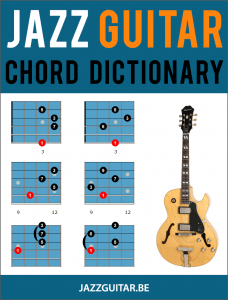
Our comprehensive reference guide includes 244 chord shapes so you can play chords with confidence!
With this chord dictionary in hand, soon you'll be able to determine the perfect 7th-chord voicings for comping or improvisation (PDF download included).
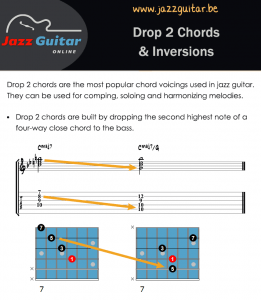
Drop 2 chords are the most popular and useful chord voicings for jazz guitarists and have been used by many great jazz guitar players such as Wes Montgomery and Joe Pass.
Download our chord chart and learn how to play drop 2 chords for comping, soloing and chord-melody arrangements.
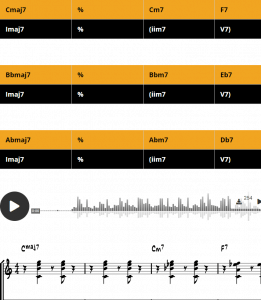
In this comping lesson, you will learn the 10 most popular jazz chord progressions with practical examples for guitar.
Chord progressions (especially the 251) are the backbone of any jazz standard and knowing how to play the most-used progressions is essential for any jazz musician. Practicing these 10 progressions will give you a head start when learning new jazz standards.
Jazz Guitar Scales are a vital part of playing jazz guitar. Getting started with jazz scales can be complicated because of the wide choice of scales. Besides knowing which scale you can use on which chord, you also need to memorize these scales over the entire fret board before you can apply them to jazz standards. Our lessons will help you in this process, the fun and easy way!
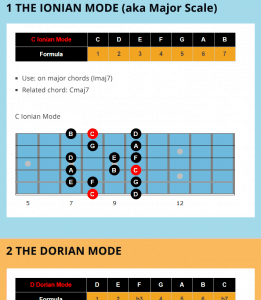
Guitar modes can be a bit confusing at the start, but once you get your head around the basic idea, you will notice modes can be quite simple and very useful for jazz guitar improvisation.
In this lesson, you will learn the modes of the major scale. You will learn the theory behind guitar modes, the different fingerings on guitar, and how to use them in your solos.
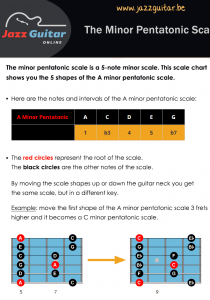
The pentatonic scale is usually one of the first scales you learn as a guitar player. It is used a lot in blues, rock, and pop, but many jazz guitar players seem to neglect this scale. This doesn't have to be the case though, because the pentatonic scale is very useful, in jazz as well as other genres.
In this lesson, you will learn all the necessary fingerings of the minor pentatonic scale, and how you can use it to spice up your jazz solos.
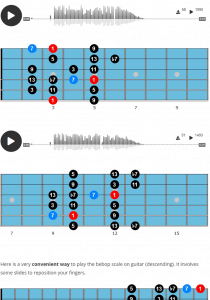
The bebop scale is one of the easiest ways to add a jazzy sound to your guitar playing. This is because you add a chromatic note to the regular modes, and chromatic notes are an important aspect of the jazz sound.
There are three types of bebop scales: the dominant, minor and major bebop scale.
In this lesson, you will learn what the bebop scales are, how they look on the guitar and how you can use these scales in your solos.

The diminished scale is used to improvise over diminished chords, which occur quite frequently in jazz chord progressions. In this lesson, you will learn the theory behind diminished scales and work on some guitar exercises to learn how to use this scale in your jazz guitar solos.
Studying jazz guitar licks is a great way to improve your jazz vocabulary. The most important aspect of studying licks is understanding the concepts and ideas behind these licks, so that you can use these ideas in your own playing.
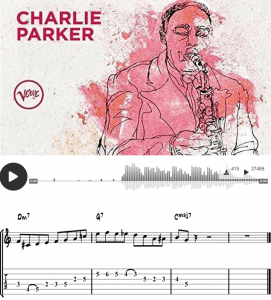
Build your jazz guitar vocabulary by learning these 50 classic bebop jazz guitar licks, as well as the important concepts behind each lick.
Learning to understand the concepts behind jazz licks is one of the most important aspects of building a jazz vocabulary.
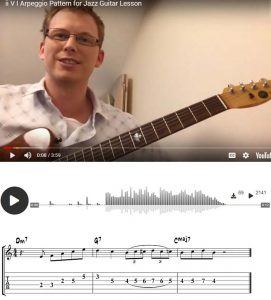
Build your jazz guitar vocabulary by learning these 25 classic bebop jazz guitar licks, as well as the important concepts behind each lick.
Learning to understand the concepts behind jazz licks is one of the most important aspects of building a jazz vocabulary.
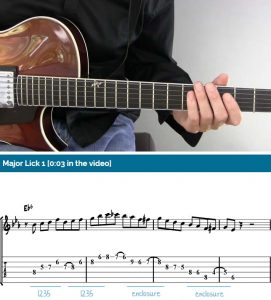
Learning jazz guitar licks is an is essential when learning how to play jazz guitar.
By studying classic jazz guitar licks, you learn how to phrase and develop rhythmic as well as melodic ideas.
In this lesson, you will learn 30 classic jazz licks over major, minor, and dominant chords.
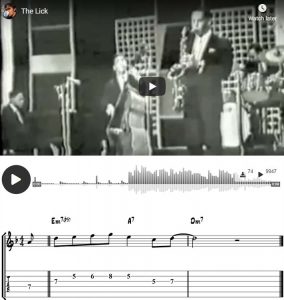
The Lick is probably the most famous jazz phrase ever, you will literally start hearing it everywhere once it gets in your ears!
The Lick is a bebop phrase that is usually played over a minor 2-5-1 but can be played over other chords as well.
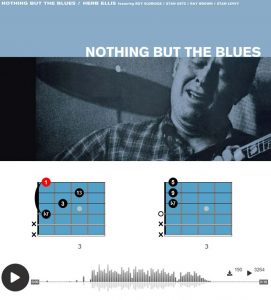
Learn how to bring out the bluesy side of jazz by studying the blues concepts of Wes Montgomery, Herb Ellis and more (16 licks and 4 solos).
Learn how you can use scales and arpeggios to jazzify your blues solos and bring variety to your blues scale cliches.
The goal of studying technique, chords, scales, arpeggios, and voice leading is to play and improvise over jazz standards. If you are new to jazz, start with some easy jazz standards such as Autumn Leaves, Summertime, or Blue Bossa.
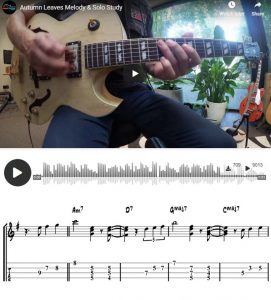
Autumn Leaves is a must-know jazz standard and an ideal jazz standard for beginning jazz guitar players and improvisers.
In this guitar lesson, you will learn a chord/melody version of Autumn Leaves. You will also learn how to solo over Autumn Leaves' chord changes with the help of some backing tracks.
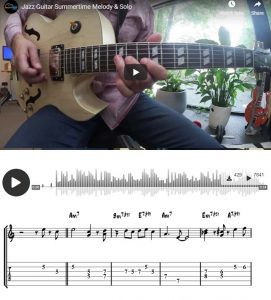
Summertime is another one of those popular jazz songs that every jazz player needs to know and a lot of fun to play and improvise over.
In this video lesson, you will learn a chord/melody arrangement of Summertime. You will also learn to improvise over the chord changes and learn a few soloing concepts.
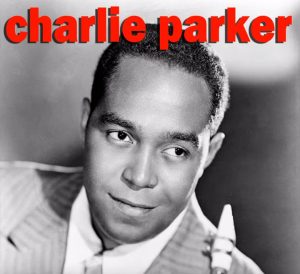
All The Things You Are is another essential jazz standard and one that is often played by beginning jazz musicians, although it has a fairly complex harmony.
In this lesson, you will analyze the harmony of All The Things, learn a chord melody arrangement and a solo study.
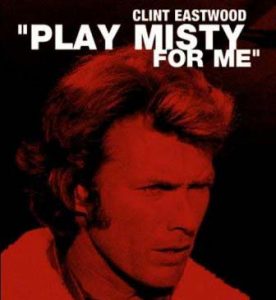
In this jazz guitar lesson, you will learn how to play Misty, a great and fun-to-play jazz ballad written by Errol Garner.
You will learn a chord melody arrangement, how to analyze and play the chords, and how to solo over Misty's chords (backing track included).
- All Of Me
- How Insensitive
- Unit 7
- Stella By Starlight
- Mr. PC
- Stompin' at the Savoy
- Take The "A" Train
- The Flintstones Theme
- Besame Mucho
Learning how to improvise a jazz guitar solo can be daunting, especially if you want your solo to tell a story that keeps your listeners interested. Combining all the scales, arpeggios, and licks you studied into a jazz guitar solo is a lot of fun though, but is a skill that needs a lot of practice.

This jazz guitar lesson is the result of a survey with the question "What is the best jazz guitar solo ever played?".
The names that made it to the top 10 are Wes Montgomery, Joe Pass, Pat Metheny, George Benson, Charlie Christian, Pat Martino, Jim Hall, Django Reinhardt, Kenny Burrell, and Grant Green.
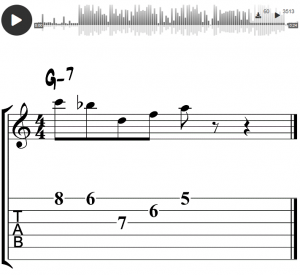
Learning jazz guitar patterns is a great way to improve your jazz vocabulary.
In this improvisation lesson, you will focus on 5 classic jazz guitar patterns that will take your jazz guitar solos to the next level.
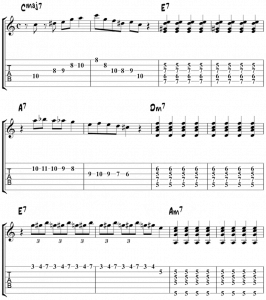
All of Me is a great jazz standard to practice your solo and improvisation skills on.
In this lesson, you will combine jazz guitar comping and improvisation over the changes of All of Me (in the style of Joe Pass). Being able to mix single-note solos and chord comping is an essential skill for jazz guitarists of all levels.
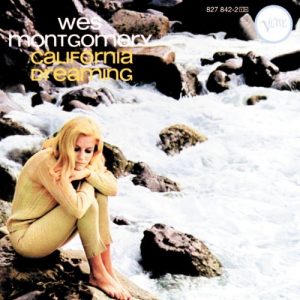
Four on Six is a great jazz standard written by Wes Montgomery in 1960 and is a lot of fun to play.
Besides learning the theme and intro, you will also learn how to improvise over Four on Six's chord changes by analyzing the chords and learning which scales and arpeggios Wes Montgomery used in his solos.
Jazz Guitar Styles
Jazz music has since its origins been influenced by other genres of music, such as blues, swing, classical, and Latin music. In this section, we have a closer look at the different styles of jazz guitar, such as bebop, jazz blues, gypsy jazz, funk jazz à la George Benson, and bossa nova.
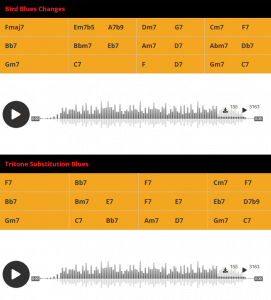
Jazz and blues have always been heavily intertwined. The type of blues played by jazz musicians is more complex than traditional blues, but both have the same characteristics.
In this guitar lesson, you will learn 6 variations of the jazz blues progression going from the basic blues to more modern variations like the bebop blues.
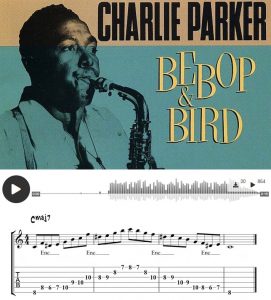
Bebop is one of the most exciting jazz styles to play on the guitar. In this lesson, you will learn the basics of bebop: chromatic notes, the bebop scales, bebop motifs and a solo over Scrapple from the Apple in the style of Charlie Parker.
Practice the bebop concepts in this lesson and you will get that "jazzy" sound in your guitar playing.
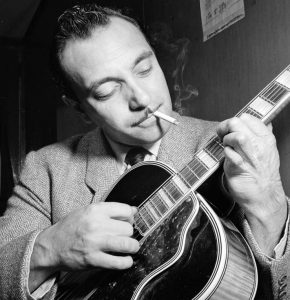
Django Reinhardt is the icon of gypsy jazz guitar and his style of playing remains popular, also today.
In this lesson, you will learn how to improvise gypsy jazz solos in the style of Django Reinhardt (video, tabs, and audio included).
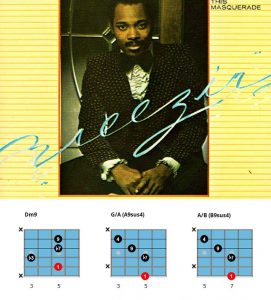
Learn how to play jazz-funk guitar, combining smooth jazz chords with the rhythmic fills of funk.
This lesson covers the basics of funk guitar, including chord rhythms and soloing. The first part of this lesson covers the rhythm guitar part, learning how to play funky guitar chords and chord progressions. In the second part you will learn how to play funk licks and fills.
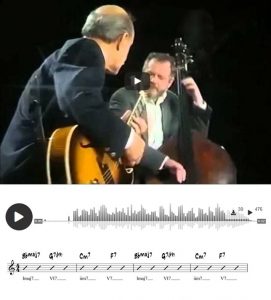
Rhythm Changes is one of the most popular song forms in jazz and essential to get under your fingers.
This doesn't mean that it is an easy chord progression. Playing an inspired jazz solo over a Rhythm Changes can be hard because of the many chords and the fast tempo it is usually played in.

Brazilian music had a great influence on players such as Stan Getz and Pat Metheny and lots of Bossa Nova songs are part of the jazz repertoire.
In this lesson, you will learn to play Brazilian jazz guitar licks and solos as you study the work of Baden Powell, Hermeto Pascoal, and more.
In this section, you will be exploring songs with a memorable guitar part that are not necessarily jazz, but tunes with a jazzy undertone.
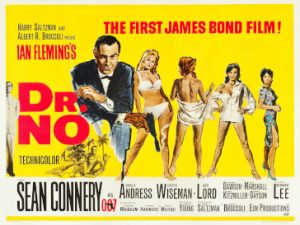
The James Bond theme song is on of the most famous movie themes ever. In this lesson, you will learn what the spy chord is and how to play the James Bond theme on guitar.
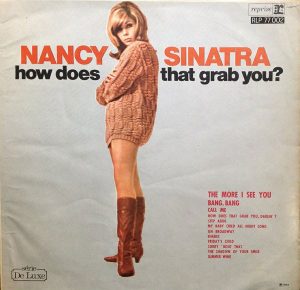
in 1966, Nancy Sinatra recorded a cover version of Bang Bang, written by Sonny Bono and originally released by Cher. The song features the iconic tremolo guitar part played by Billy Strange, which you will learn in this lesson.
Although music theory has a bit of a bad reputation, it can make your life as an improvising guitarist a lot easier. Music theory brings all technical aspects of learning jazz guitar together in an understandable framework that supports your improvisational skills.
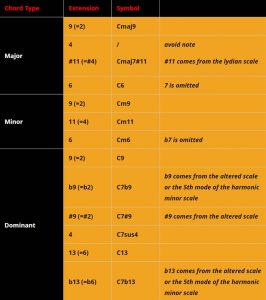
In this music theory lesson, you will learn how to construct jazz guitar chords from scratch.
Understanding this essential theory will make finding chords on the fretboard much easier and it will take the guesswork out of playing jazz chords.
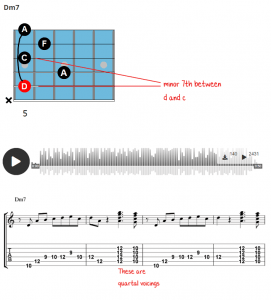
Improvising on the guitar requires you have a good understanding of note relationships on the fretboard.
In this lesson, you will learn about musical intervals, how they look on the guitar, and how you can practice intervals so you can use them in your solos.
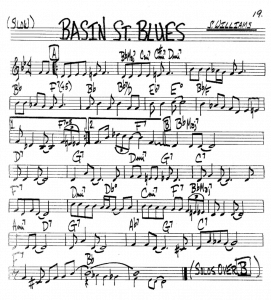
In this lesson, you will learn how to read jazz chords on lead sheets the way they appear in fake books such as the Real Book.
You will learn how to color your chords, use chord tensions and substitutions while making sure your chords don't clash with the melody.
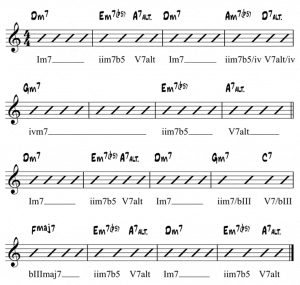
Being able to analyze jazz harmony is an important skill for any jazz musician.
In this lesson, you will learn how to use Roman numerals for musical analysis and transposing on the guitar. This essential music theory lesson includes full song examples.

In this music theory lesson, you will learn what guitar positions are and how they can help you become a better guitar player.
By the end of the article, you will have a clear system so that you can confidently play major scales over the entire fretboard
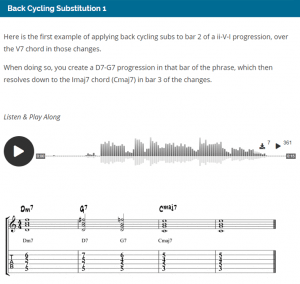
Back cycling is an important concept in jazz music.
In this lesson, you will learn what back cycling is exactly, and how you can apply it to your solos and jazz chord progressions.
Jazz Listening Guides & Books
In this section of the website you will get answers to questions like "What are the best jazz guitar albums?" or "Which jazz guitar books should I buy to get started?".

Here is a top 100 of best jazz guitar albums, as voted by our readers.
If you are new to jazz guitar, this listening guide is a good place to start, with a wide variety of styles and jazz guitarists.
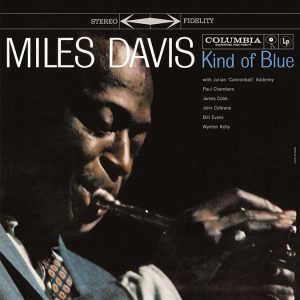
This listening guide is a top 100 of jazz albums that don't have a guitar player in the leading role.
If you are looking for a new jazz music to listen to, this is a great starting place.
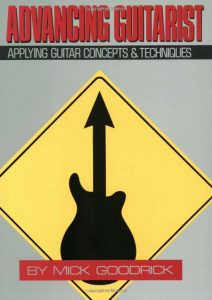
There's a ton of jazz guitar books available nowadays, some are great, some are not so great.
This top 50 compiled by our readers is a great place to start if you are looking for a new book to dive into.
The list is divided into four categories: jazz guitar books, guitar books that are not jazz related, theory & reference books, and other music books.

A guide for those that want to take their guitar playing to the next level and are looking for a jazz guitar university program.
Finding and making a choice between the available schools can be though. This guide will help you make your choice.

In this tutorial, I explain how I use Band in a Box to make my jazz guitar practice routine more fun and effective, starting with a review of the basics.
Posted by: carlitallise0194267.blogspot.com
Source: https://www.jazzguitar.be/blog/jazz-guitar-lessons/
Post a Comment for "modern jazz voicings pdf free download"